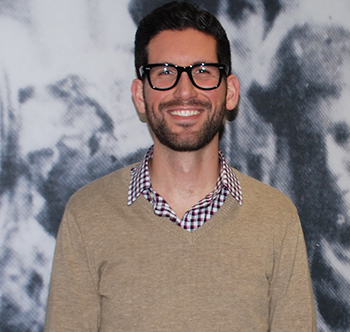
Hrag Yedalian
When you use indexing terms to search through USC Shoah Foundation’s first 60 Armenian Genocide interviews in the Visual History Archive, or rely on the subtitles to understand the Armenian-language interviews, think of Hrag Yedalian.
Yedalian, USC Shoah Foundation program coordinator of audiovisual collections, is one of only a few select staff who have been working to index and subtitle the first batch of interviews (of about 400 total) that make up the Visual History Archive’s new Armenian Genocide Collection. The interviews were recorded by filmmaker J. Michael Hagopian beginning in the 1970s and the Armenian Film Foundation delivered them to USC Shoah Foundation last year.
With the help of Crispin Brooks, curator of the Visual History Archive, and Professor Richard Hovannisian, who is an advisor to the collection, Yedalian has indexed the first 60 interviews and created subtitles for the ones that are in Armenian. These testimonies will be available to view in the Visual History Archive April 24, 2015, the 100th anniversary of the Armenian Genocide.
Yedalian’s history with Hagopian goes back further than the filmmaker’s partnership with USC Shoah Foundation, which began in 2010. In 2009, Yedalian was working for Los Angeles Councilmember Paul Krekorian when he made a short film honoring Hagopian, an esteemed member of the Los Angeles Armenian-American community. After meeting Hagopian, Yedalian couldn’t believe no one had ever made a film about him before.
He asked Hagopian if he’d be willing to participate in a documentary, and Hagopian said yes. But just a few months later, he passed away at age 97.
Ever since Hagopian’s collection was digitized and delivered to USC Shoah Foundation last year, Yedalian has devoted his time almost exclusively to indexing and subtitling the collection. With Hovannisian, he has watched each of the first 60 interviews several times (each one is about 15 minutes long) and worked with Brooks and other scholars to identify 118 new indexing keywords for the collection.
The new keywords include places, events, and historical figures that have never been mentioned in the Visual History Archive before, as well as filmmaking terms like “zoom” and “pan” that refer to Hagopian’s unique interview style.
Yedalian said the subject matter of the Armenian Genocide can be quite complicated to index. In one common story he heard in many testimonies, Armenian parents, knowing they were certain to die in a death march, would leave children behind or actively give them away, hoping they would find a home with another family and be saved. However, children’s fates differed wildly; some were adopted into loving homes and others were abused. Yedalian and Hovannisian must consider each interview individually and decide which of the keywords, such as “child placement,” “abduction,” “adoption,” or “child abandonment” best characterizes each particular survivor’s experience.
Subtitling also presents its own set of challenges. Sometimes interviewees will sing songs or recite poetry, which needs to be translated. Yedalian is also extremely careful to retain the speaker’s original intent and not misinterpret what he or she is saying. Dialects are also difficult to translate.
Unlike the other testimonies in the Visual History Archive, the Armenian interviews are very short and often include little context. Sometimes Yedalian doesn’t know where an interviewee was born or when. As a result, Yedalian and Hovannisian have had to “over-index,” to account for each and every topic the interviewees mention, since they can’t rely on context to explain what they are talking about.
“Every single reference is substantial because we don’t have a lot of material. Everything’s a gem,” Yedalian said.
Yedalian said it’s personally fulfilling to know he had a role in bringing the collection to life. It is “unprecedented” for the Armenian community to have access to firsthand, videotaped interviews of survivors and witnesses like those in the Armenian Genocide Collection, so he knows the collection will mean a great deal to many people.
Though the work has been difficult, he is most proud of the attention to detail that is being put into the collection. This will ensure it is a valuable resource for students, scholars and the public.
“Because the collection is so small and because the interviews are so short, the amount of care we can provide to them is just exceptional, and that really is the difference,” he said.